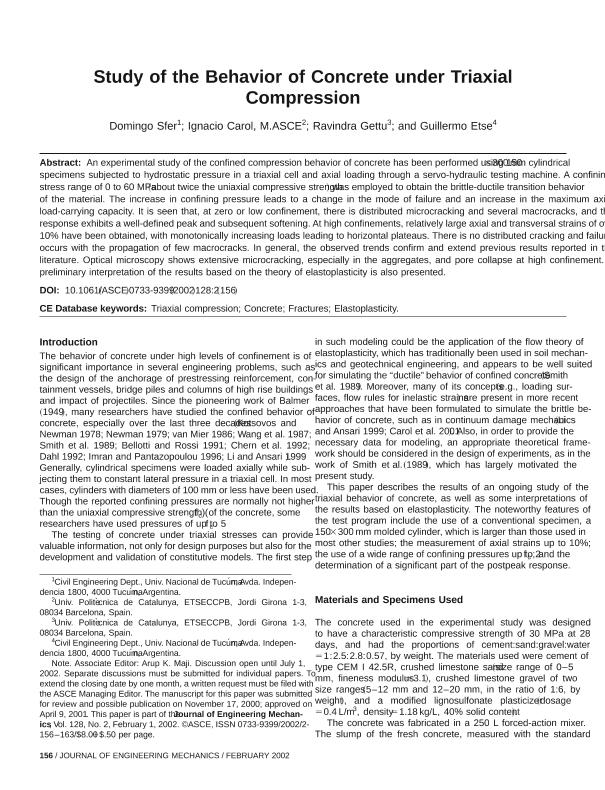Mostrar el registro sencillo del ítem
dc.contributor.author
Sfer, Domingo

dc.contributor.author
Carol, Inés

dc.contributor.author
Gettu, R.
dc.contributor.author
Etse, Jose Guillermo

dc.date.available
2019-06-14T18:52:07Z
dc.date.issued
2002-02
dc.identifier.citation
Sfer, Domingo; Carol, Inés; Gettu, R.; Etse, Jose Guillermo; Study of the behavior of concrete under triaxial compression; American Society of Civil Engineers; Journal Of Engineering Mechanics; 128; 2; 2-2002; 156-163
dc.identifier.issn
0733-9399
dc.identifier.uri
http://hdl.handle.net/11336/78374
dc.description.abstract
An experimental study of the confined compression behavior of concrete has been performed using 150x300 mm cylindrical specimens subjected to hydrostatic pressure in a triaxial cell and axial loading through a servo-hydraulic testing machine. A confining stress range of 0 to 60 MPa (about twice the uniaxial compressive strength) was employed to obtain the brittle-ductile transition behavior of the material. The increase in confining pressure leads to a change in the mode of failure and an increase in the maximum axial load-carrying capacity. It is seen that, at zero or low confinement, there is distributed microcracking and several macrocracks, and the response exhibits a well-defined peak and subsequent softening. At high confinements, relatively large axial and transversal strains of over 10% have been obtained, with monotonically increasing loads leading to horizontal plateaus. There is no distributed cracking and failure occurs with the propagation of few macrocracks. In general, the observed trends confirm and extend previous results reported in the literature. Optical microscopy shows extensive microcracking, especially in the aggregates, and poce collapse at high confinement. A preliminary interpretation of the results based on the theory of elastoplasticity is also presented.
dc.format
application/pdf
dc.language.iso
eng
dc.publisher
American Society of Civil Engineers

dc.rights
info:eu-repo/semantics/openAccess
dc.rights.uri
https://creativecommons.org/licenses/by-nc-sa/2.5/ar/
dc.subject
Triaxial Compression
dc.subject
Concrete
dc.subject
Fractures
dc.subject
Elastoplasticity
dc.title
Study of the behavior of concrete under triaxial compression
dc.type
info:eu-repo/semantics/article
dc.type
info:ar-repo/semantics/artículo
dc.type
info:eu-repo/semantics/publishedVersion
dc.date.updated
2019-06-14T15:10:00Z
dc.journal.volume
128
dc.journal.number
2
dc.journal.pagination
156-163
dc.journal.pais
Estados Unidos

dc.journal.ciudad
New York
dc.description.fil
Fil: Sfer, Domingo. Universidad Nacional de Tucumán. Facultad de Ciencias Exactas y Tecnología; Argentina
dc.description.fil
Fil: Carol, Inés. Universidad Politécnica de Catalunya; España
dc.description.fil
Fil: Gettu, R.. Universidad Politécnica de Catalunya; España
dc.description.fil
Fil: Etse, Jose Guillermo. Universidad Nacional de Tucumán. Facultad de Ciencias Exactas y Tecnología; Argentina. Universidad Nacional de Tucumán. Facultad de Ciencias Exactas y Tecnología. Centro de Métodos Numéricos y Computacionales en Ingeniería; Argentina. Consejo Nacional de Investigaciones Científicas y Técnicas. Centro Científico Tecnológico Conicet - Tucumán; Argentina
dc.journal.title
Journal Of Engineering Mechanics

dc.relation.alternativeid
info:eu-repo/semantics/altIdentifier/doi/https://dx.doi.org/10.1061/(ASCE)0733-9399(2002)128:2(156)
dc.relation.alternativeid
info:eu-repo/semantics/altIdentifier/url/https://ascelibrary.org/doi/10.1061/%28ASCE%290733-9399%282002%29128%3A2%28156%29
Archivos asociados
